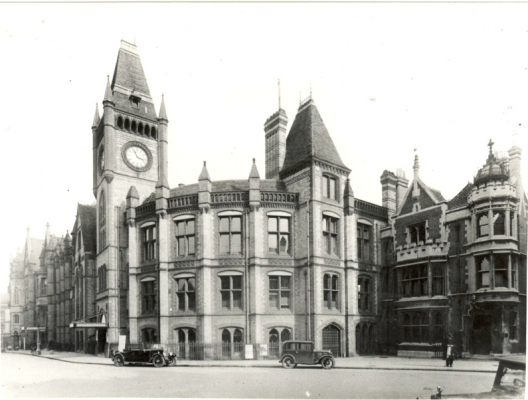The Town Hall has made some significant contributions to Reading’s culture since it was first built in 1786. The building is currently home to Reading Museum and the Concert Hall, but over the years it has had several other claims to fame.
Cinema
The Town Hall was the first documented place in the town to show a film, with screenings starting in 1909, just before Reading’s first actual cinema opened.
The first cinema event was advertised as ‘Mr Waller Jeff’s New Century Pictures’ and cost between 3-6d. Mr Jeff exhibited North American Company films of the British expedition to North America, East Borneo and scenes of war. He also included some local interest films of people making biscuits.
Waller Jeff was one of a few cinema pioneers who would travel the country introducing new audiences to film before there were purpose built cinemas. At this time films would have been shown wherever there was space; besides the Town Hall there are records of films being shown in a department store in Broad Street and as part of a fair in Forbury Gardens.
It is likely that there was some form of film was shown in Reading before 1909 because when the Reading Chronicle reviewed the performance in the Town Hall they said: “Cinematograph entertainments are a source of never failing interest in Reading.” The film event must have been popular as Mr Jeff even felt generous enough to donate a day’s taking to the mayor’s soup kitchen.
Music
The Concert Hall is located within the historic Town Hall. The Town Hall was first built in 1786 as a purely administrative space consisting largely of what is now known as the Victoria Hall. In 1864, The Town Hall began its journey into becoming a music venue with the installation of an organ
The Town Hall continued with a range of construction and refurbishments until 1882 when a fully functioning Concert Hall was added. This was followed shortly by the addition of a museum and library in 1883-84.
In 1943 the building was seriously damaged during an air raid, and then in the mid-1980s it suffered further threat; the relocation of the library and civic offices combined with a newly built civic centre (including the Hexagon) meant the Town Hall and Concert Hall faced closure. Plans to demolish and replace the Town Hall with a new cultural centre were proposed, but it was decided instead to refurbish the building to bring it up to date whilst retaining its heritage, and so the Concert Hall was closed between 1986 and 2000 to be refurbished. It is now open again and in constant use. In 1974 the Concert Hall was also listed as a Grade II listed building, further underpinning its historical importance.
Father Willis Organ
The Organ was built in 1864 as part of the refurbishment of the Small Town Hall, now known as the Victoria Hall. The Reading Philharmonic Society suggested the hall should have an organ. It was designed by Henry Willis, one of Britain’s foremost organ makers, he even built the organ in the Royal Albert Hall. He was so good that he earned the nickname “Father Willis” for his contribution to organ building, over his lifetime he built over 2,000 of them.
In its heyday, the organ would’ve been the loudest sound anyone would’ve heard, with reports of some members of the audience even running out the room scared when it was played. This was possible due to Father Willis’s new design that allowed more air to be pushed through the pipes without making the keyboard harder to play (previously, as more air was passed through, the pressure needed to play the keyboard grew too much). The Concert Hall organ was one of the first to use this technology.
Unfortunately, the organ was incomplete for its opening concert; however by Christmas of 1864 the organ was finished and Father Willis himself gave a recital in 17th December 1864.
The concert hall was redesigned towards the end of the 19th century and reopened on 31st May 1882. The organ was upgraded and re-scaled to match the tonal qualities of the new hall, increasing its number of pipes from the original 1660 to 2238. In 1999 the organ was restored by Harrison and Harrison with support from the Heritage Lottery Fund. It was decided to restore the pitch to that of the original in 1882. The concert hall was re-opened in 2000 and the organ continues to be a central feature.



